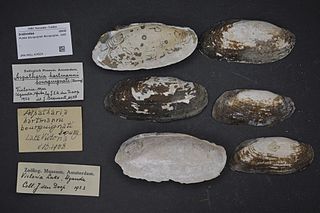 W
WUnionida is a monophyletic order of freshwater mussels, aquatic bivalve molluscs. The order includes most of the larger freshwater mussels, including the freshwater pearl mussels. The most common families are the Unionidae and the Margaritiferidae. All have in common a larval stage that is temporarily parasitic on fish, nacreous shells, high in organic matter, that may crack upon drying out, and siphons too short to permit the animal to live deeply buried in sediment.
 W
WAnodontites is a genus of freshwater mussels, aquatic bivalve mollusks in the family Mycetopodidae. Anodontites are present in South and Middle America, as far north as Mexico.
 W
WChambardia wahlbergi is a species of bivalve belonging to the family Iridinidae.
 W
WHyriidae is a taxonomic family of pearly freshwater mussels, aquatic bivalve molluscs in the order Unionida. This family is native to South America, Australia, New Zealand and New Guinea. Like all members of that order, they go through a larval stage that is parasitic on fish.
 W
WIridinidae is a family of medium-sized freshwater mussels, aquatic bivalve mollusks in the order Unionida.
 W
WThe Mycetopodidae are a family of freshwater pearly mussels in the order Unionida restricted to South America. They are named for the mushroom-like shape of their foot. Like all members of the Unionida they reproduce via a larval stage that temporarily parasitizes fish. Banarescu lists four subfamilies with ten genera in total.
 W
WUnionida is a monophyletic order of freshwater mussels, aquatic bivalve molluscs. The order includes most of the larger freshwater mussels, including the freshwater pearl mussels. The most common families are the Unionidae and the Margaritiferidae. All have in common a larval stage that is temporarily parasitic on fish, nacreous shells, high in organic matter, that may crack upon drying out, and siphons too short to permit the animal to live deeply buried in sediment.